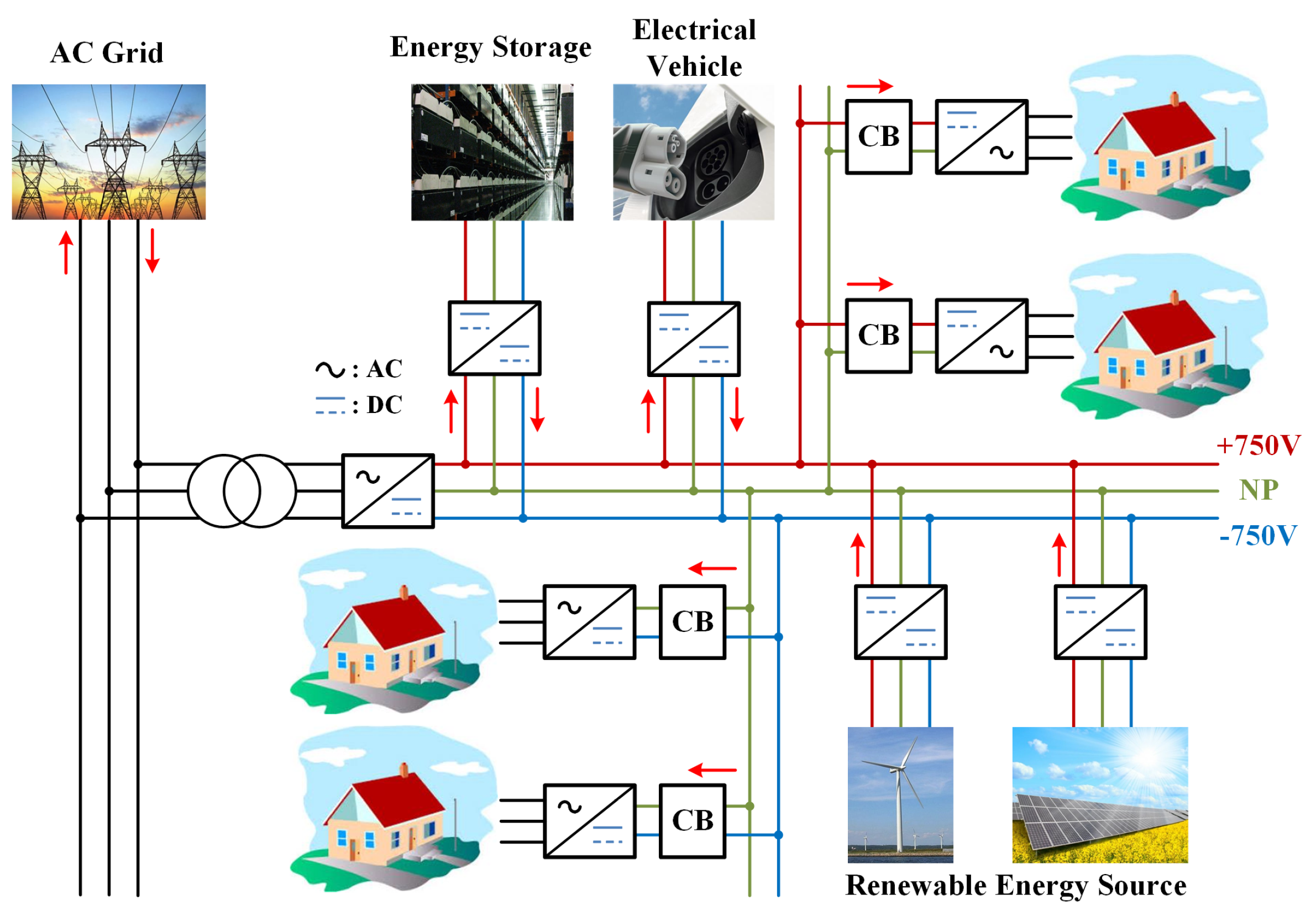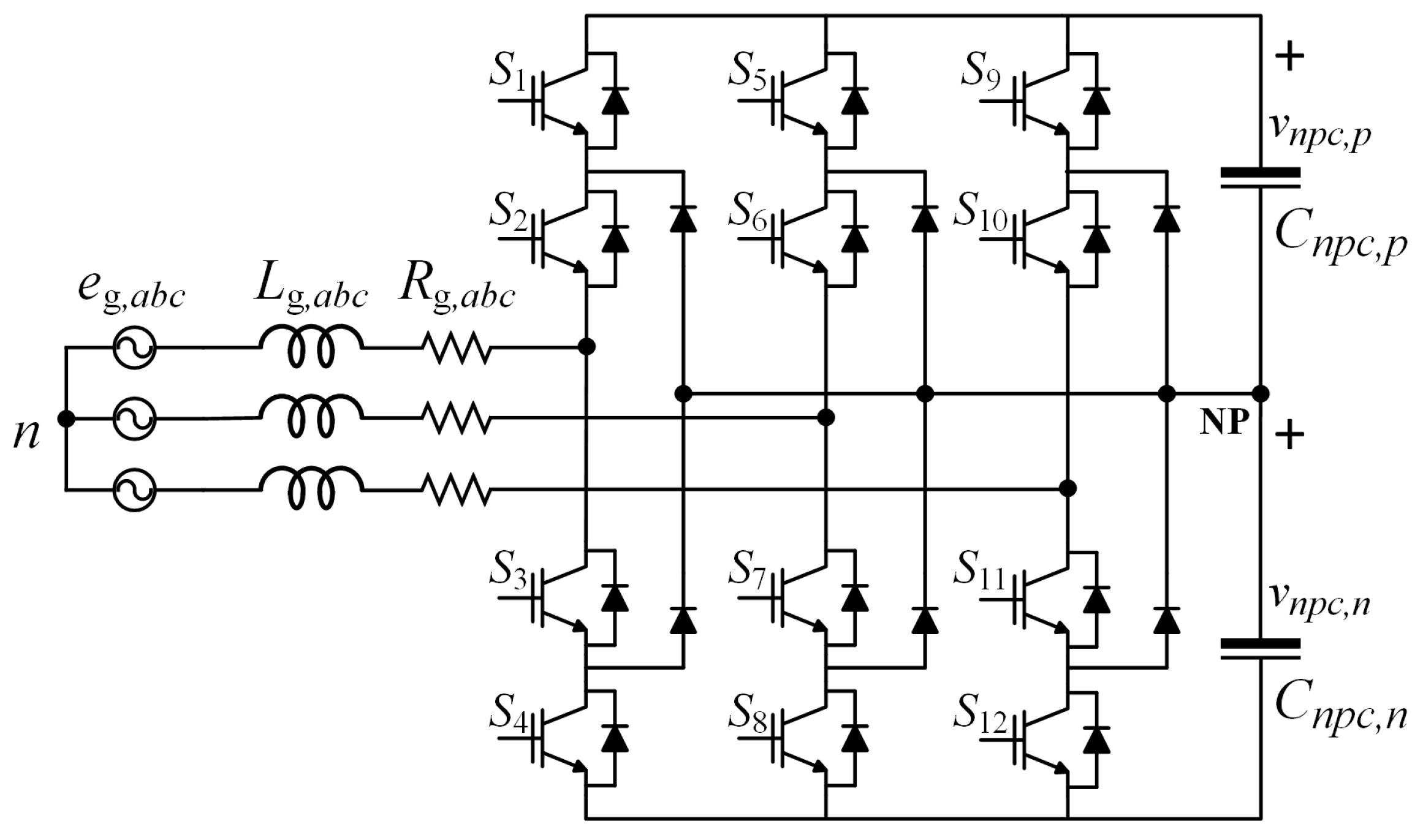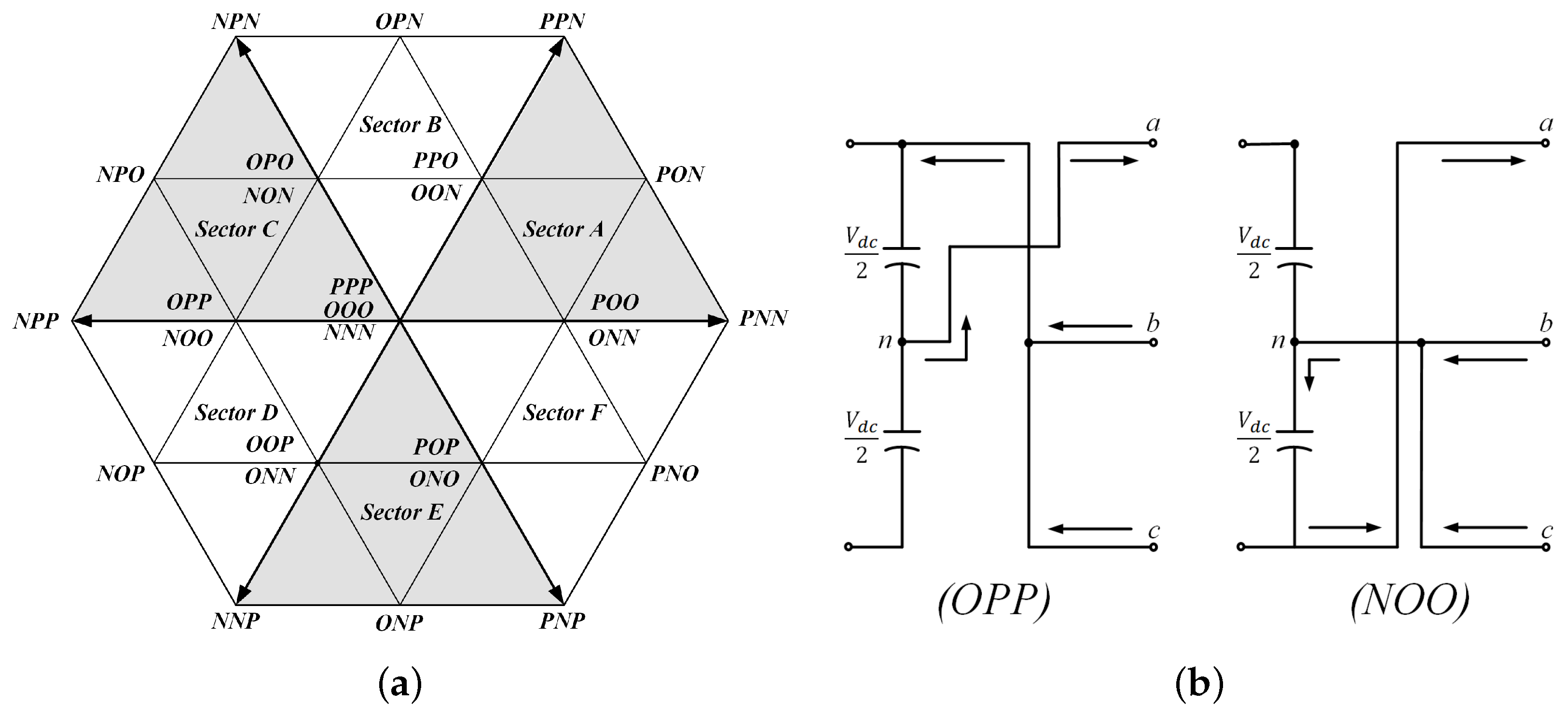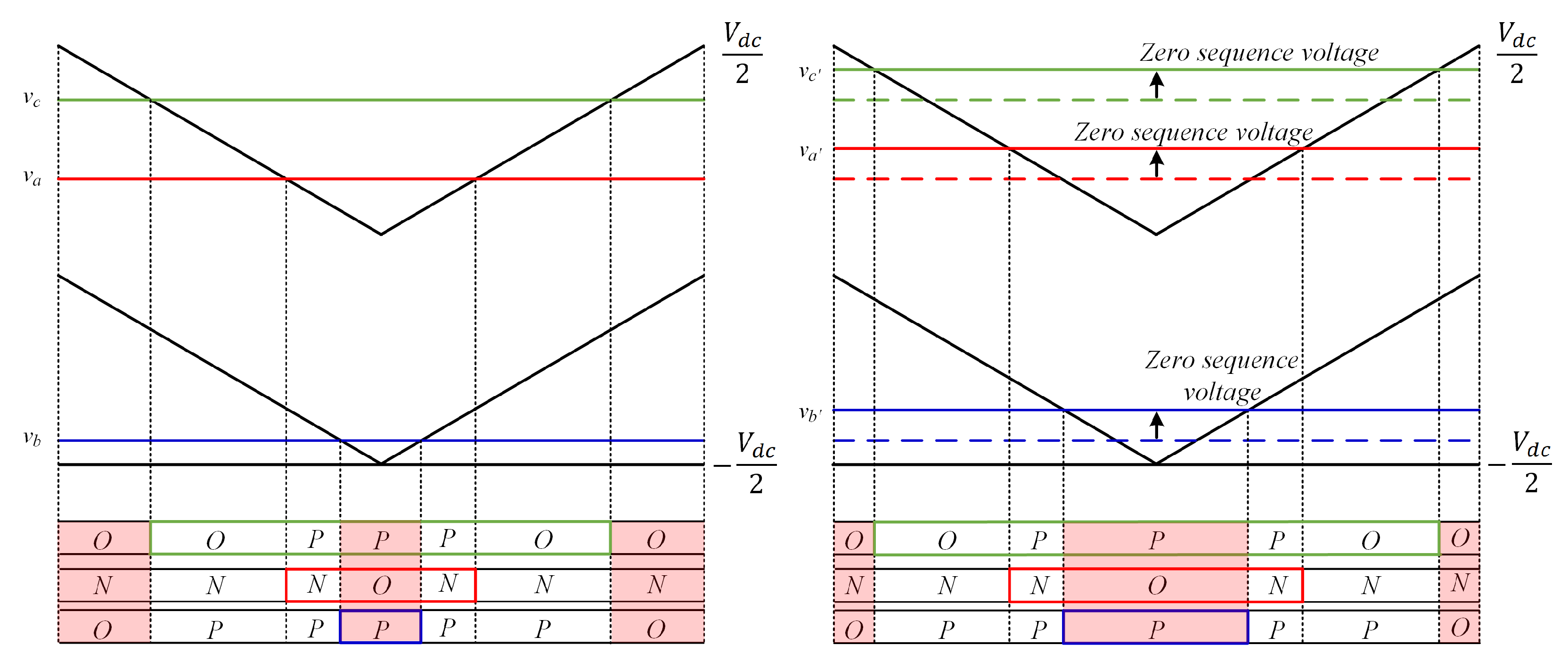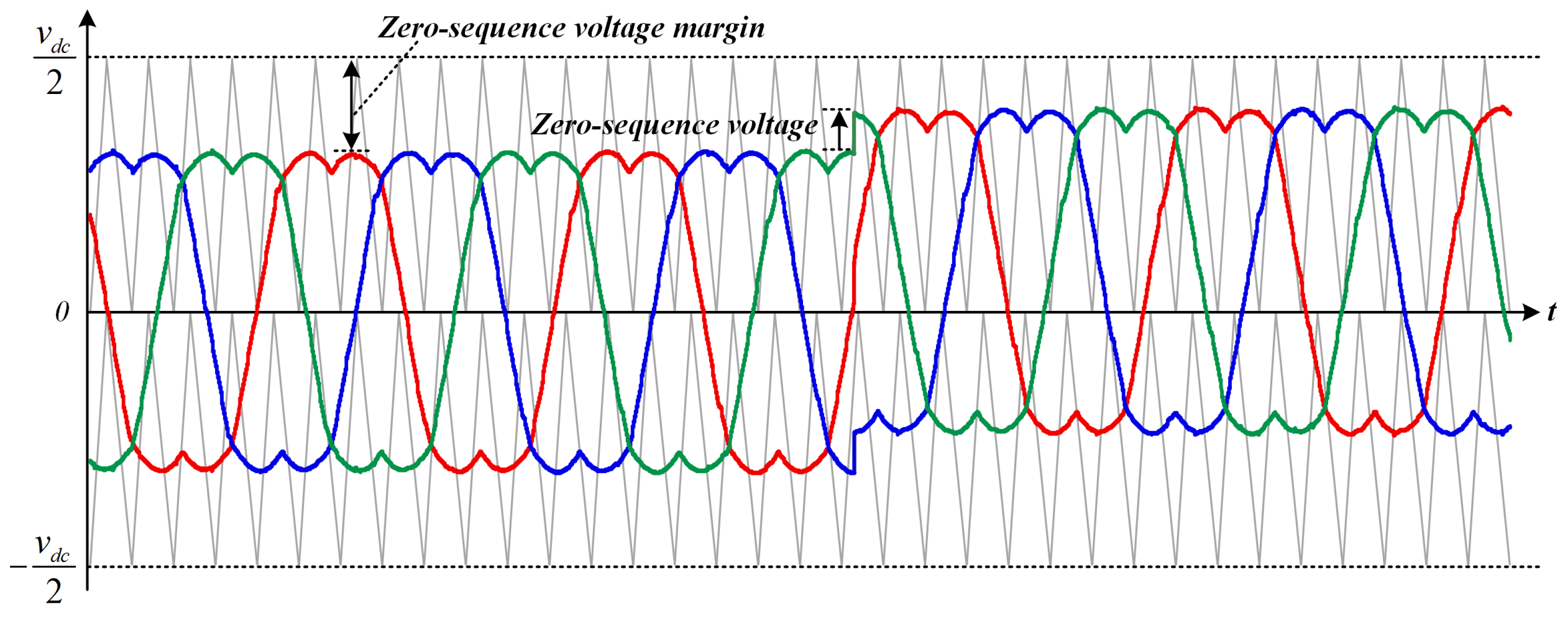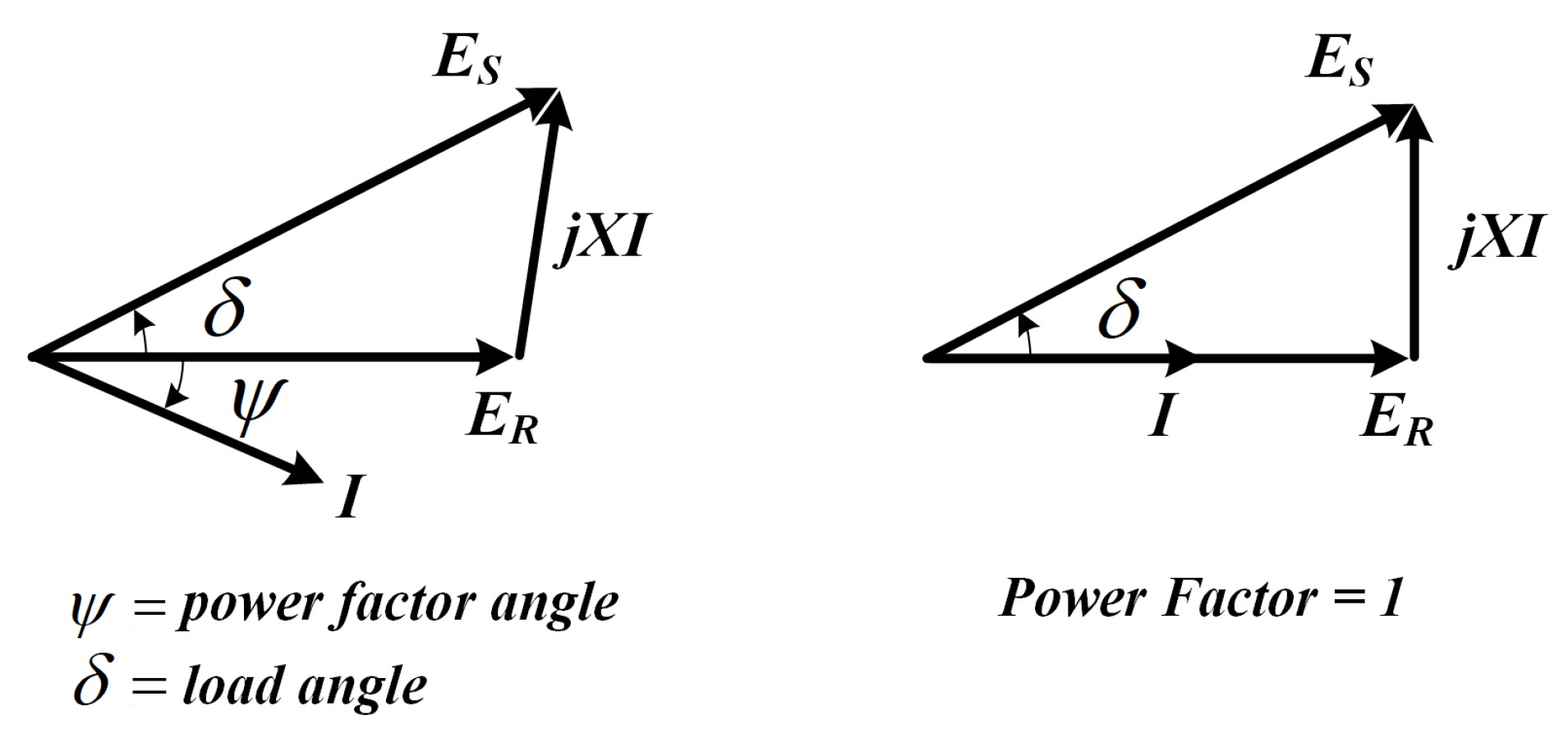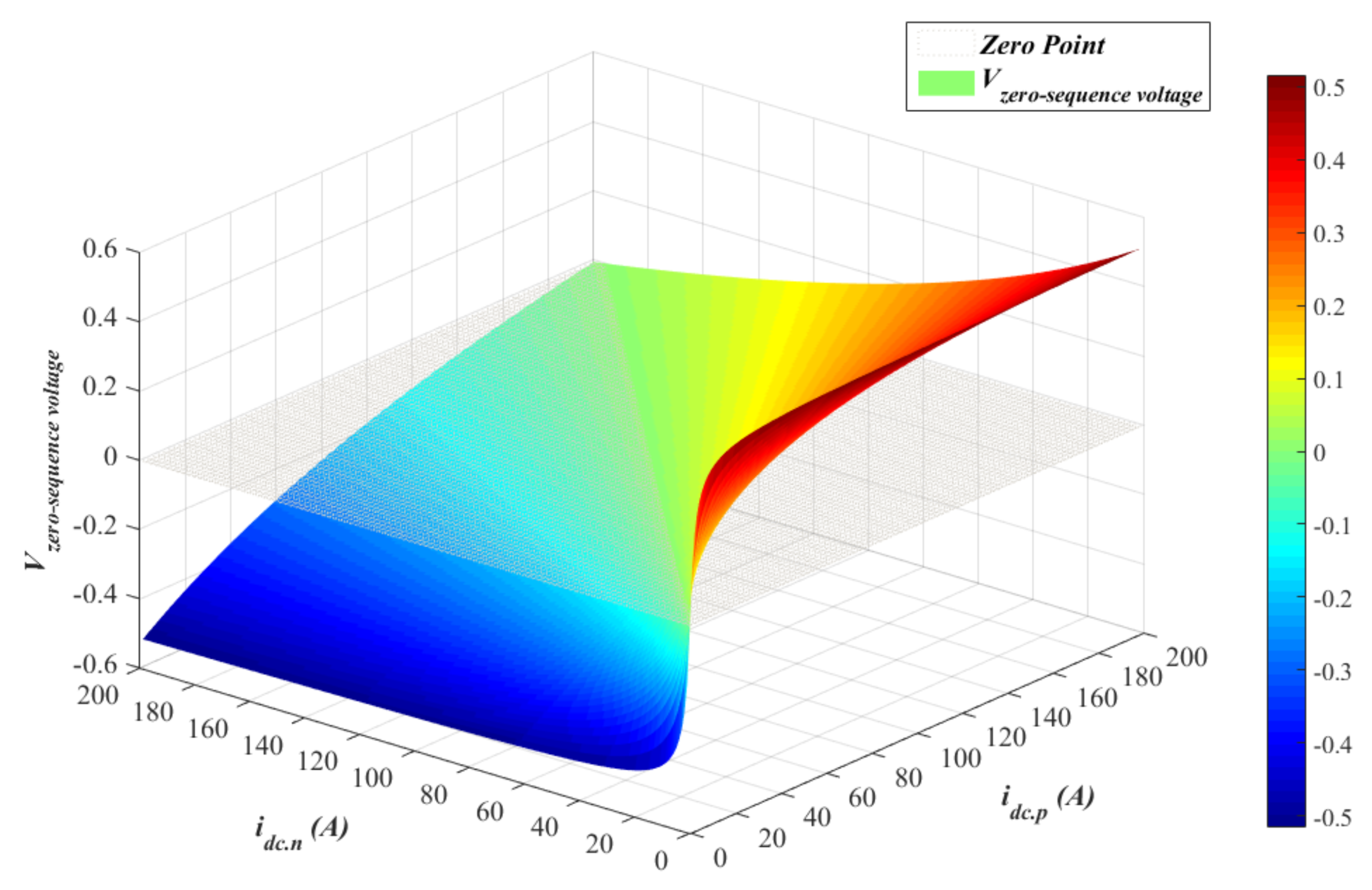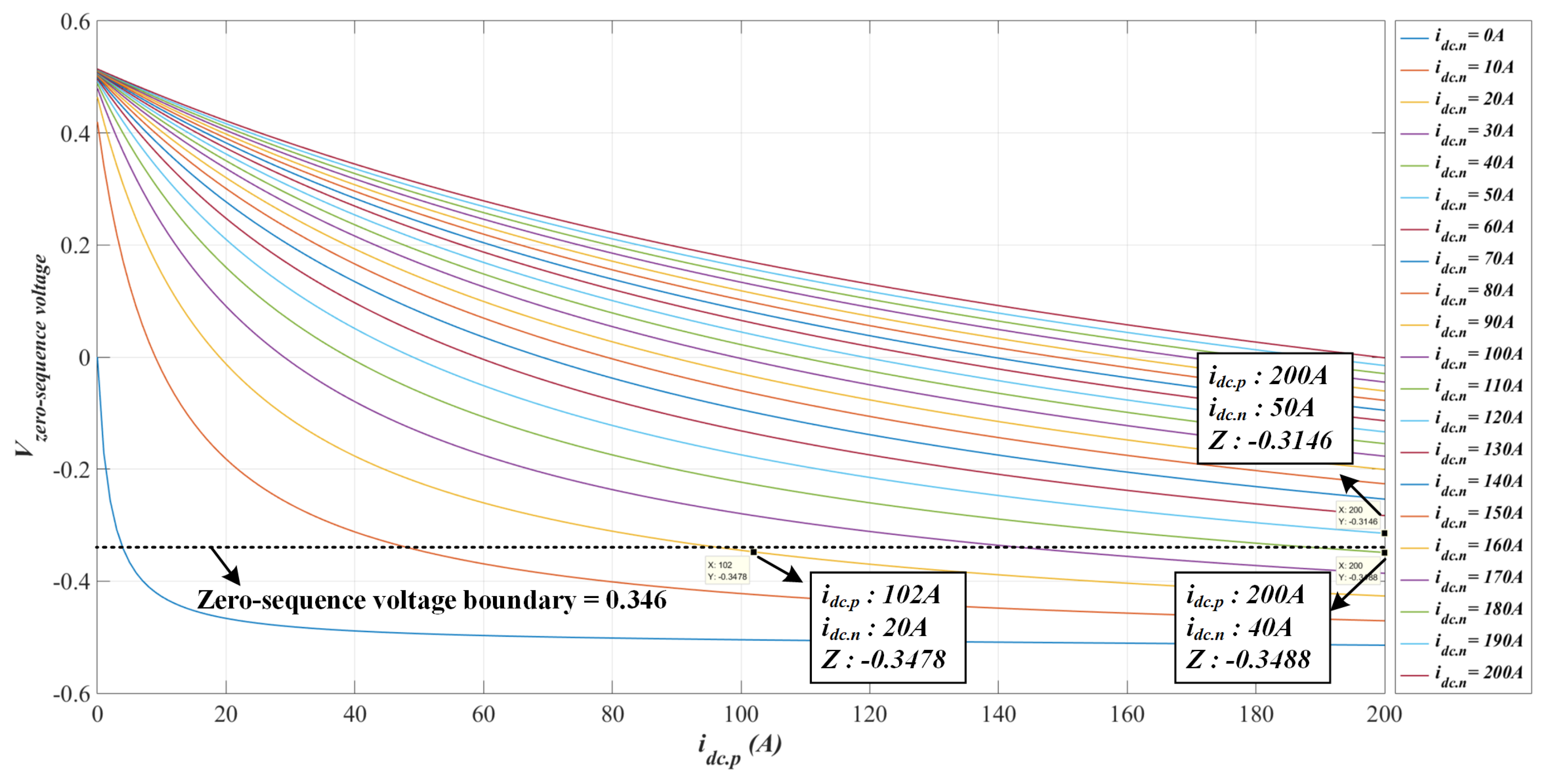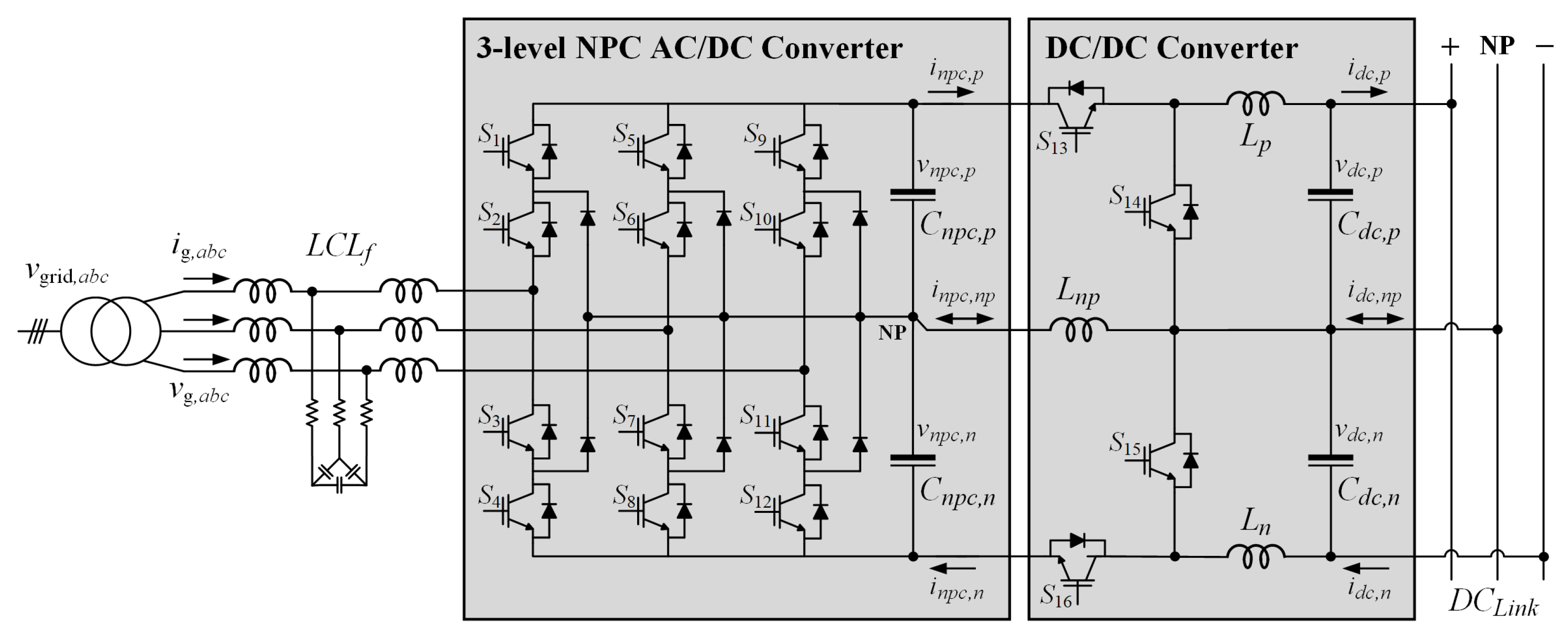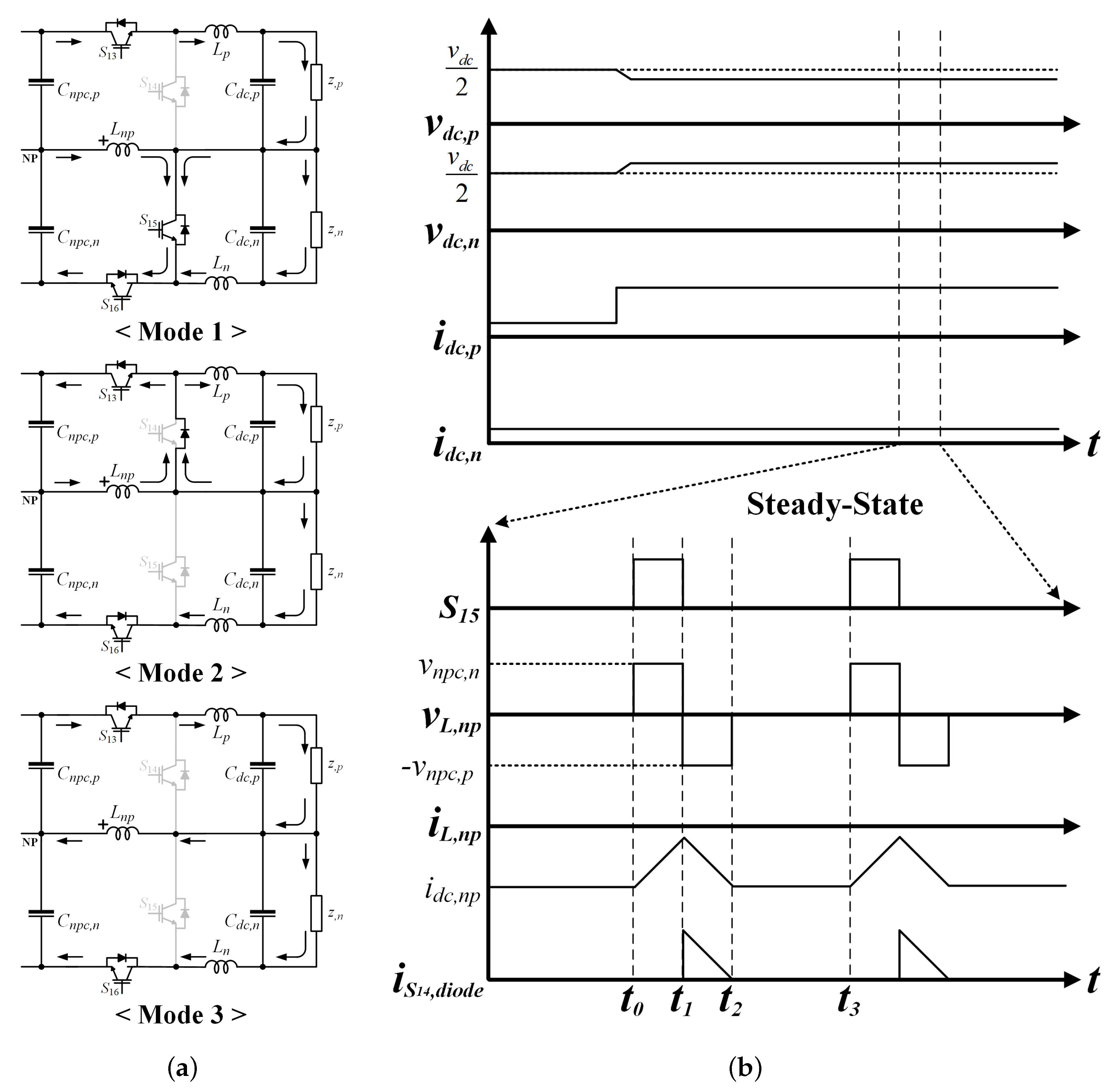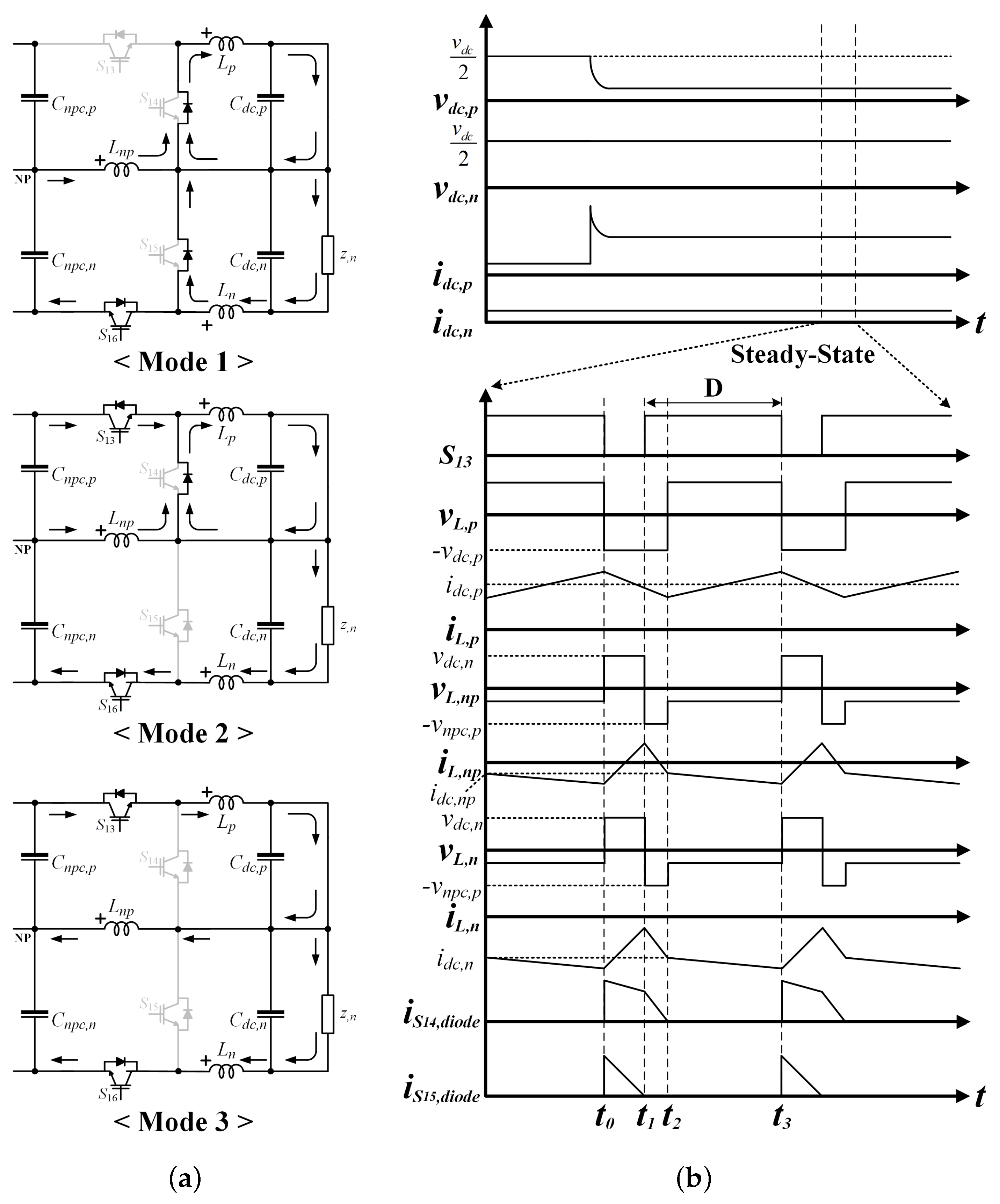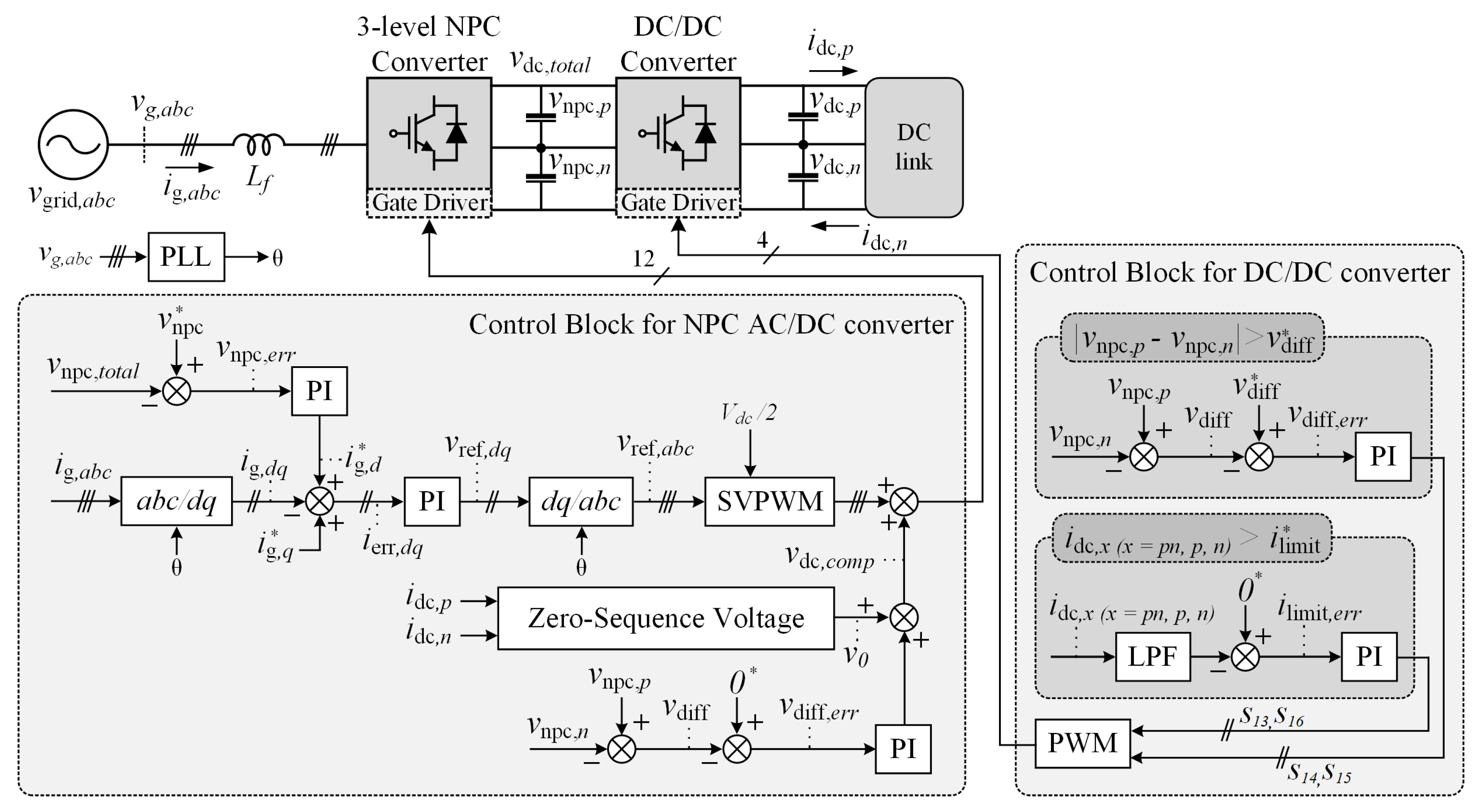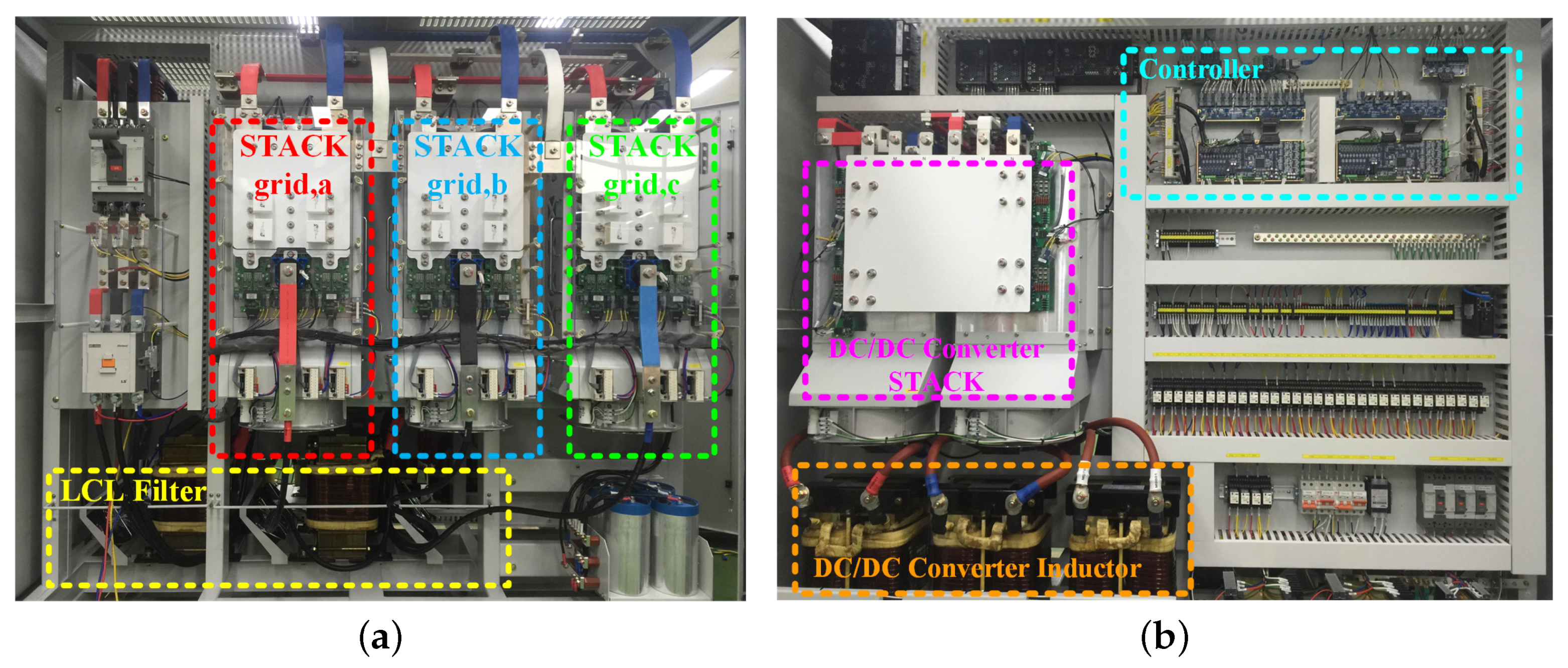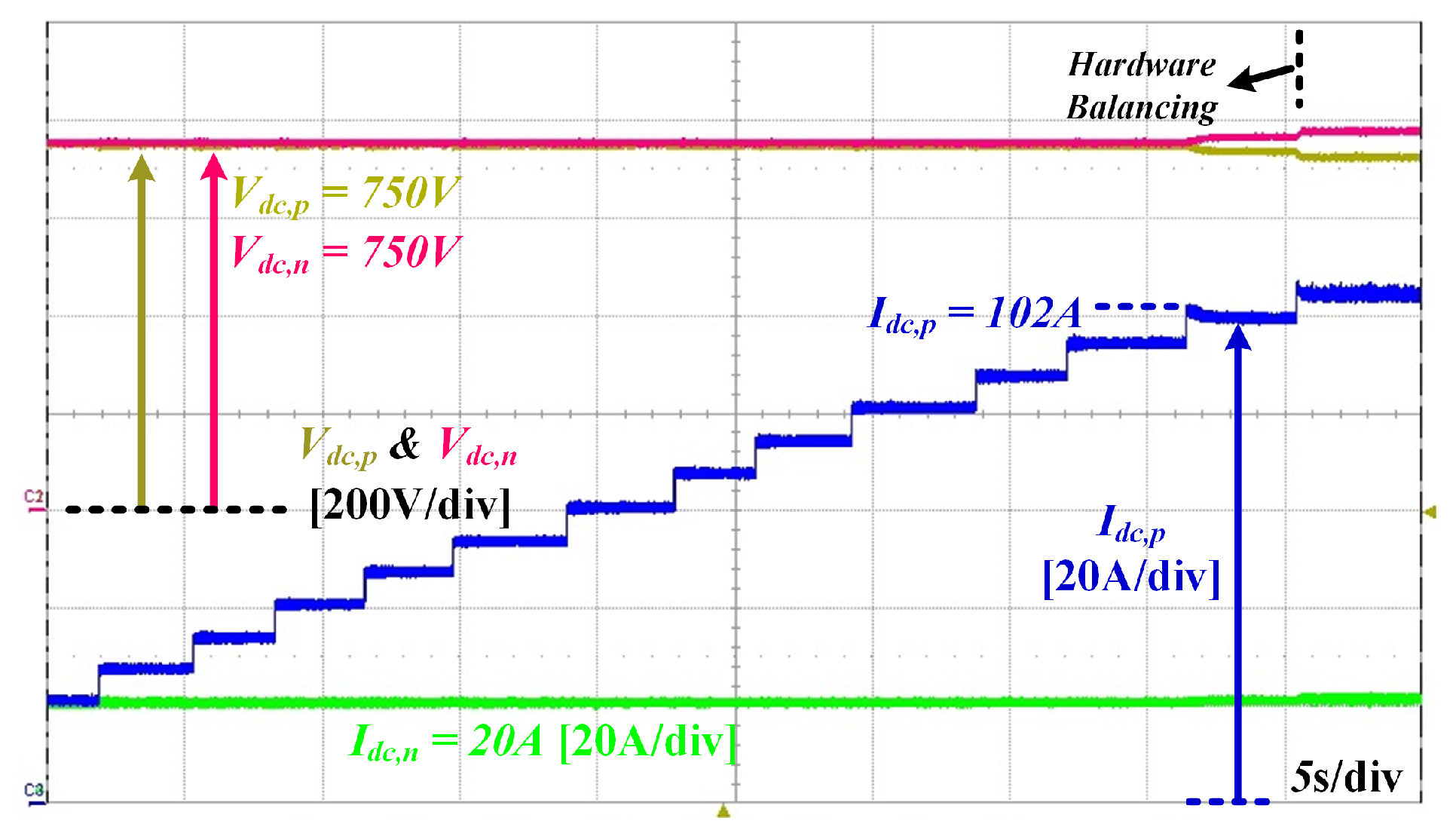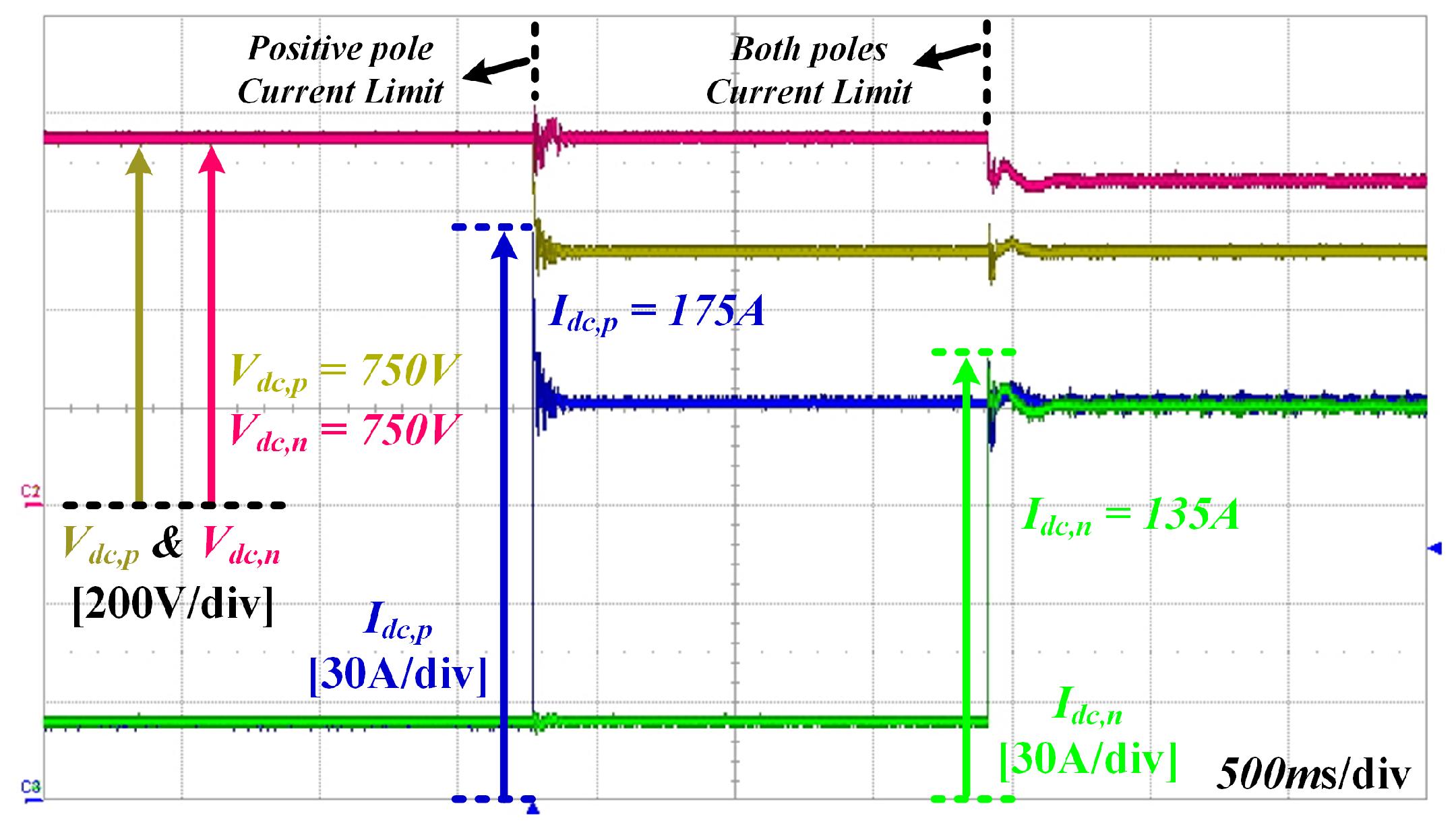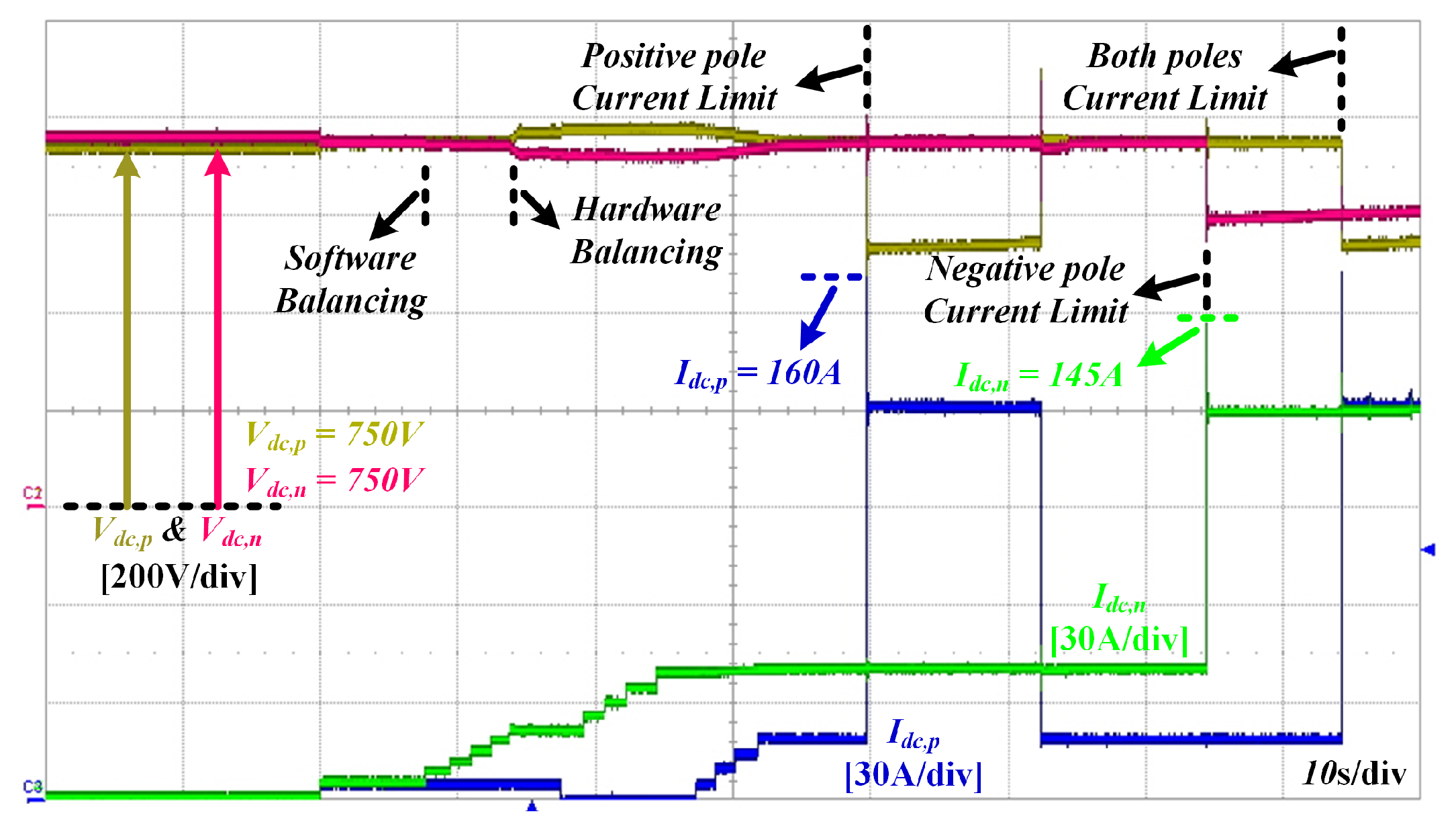1. Introduction
In recent years, due to resource depletion and environmental problems such as pollution and climate change, renewable energy sources such as photovoltaic (PV) cells and wind energy have been supplied to replace fossil fuels. Along with the increase in renewable energy sources, increasingly, energy storage systems (ESS) and DC loads have led to an interest in the low-voltage direct current (LVDC) distribution [
1,
2,
3]. Compared with AC distribution, LVDC distribution has several advantages [
4,
5,
6]. LVDC distribution is easy to connect to renewable energy sources and ESS, which are DC sources. Due to the increased DC load, LVDC distribution can increase energy efficiency by eliminating unnecessary power conversion and minimizing power conversion [
7,
8]. In addition, by reducing the power conversion process, it is possible to make the equipment lighter and smaller and to improve the reliability of LVDC distribution. Since DC does not have a frequency, there is no reactance component and no reactive power. Therefore, there is no skin effect during distribution. Besides that, LVDC distribution has advantages such as high transmission capacity, low transmission loss, low environmental impact, and low investment costs [
9,
10,
11].
Previous studies on the LVDC distribution system have validated its performance and impact in industrial and commercial applications [
12,
13]. A variety of DC distribution schemes have been proposed [
14,
15,
16]. The existing AC distribution network consists of 3-phase AC power wires; so, if LVDC distribution is configured as bipolar, it can use a previously installed AC distribution network as a DC distribution network without additional installation [
17,
18]. There are many economic benefits from the supplier side. The bipolar ±750 V
distribution system has been reported to have the advantages of high power dissipation, low conduction losses, and good user safety [
19]. In this paper,
Figure 1 shows the LVDC distribution system with a bipolar ±750 V
output voltage considering the dielectric strength of the previously installed wires.
The proposed LVDC distribution requires the bipolar AC/DC converter due to the bipolar power distribution. Several converters have been studied to find a two-line converter for the bipolar power distribution [
20,
21,
22,
23]. The 12-pulse thyristor converter is suitable for bipolar output converters [
20,
21]. However, it has a low power factor (PF). Additionally, two separated thyristor converters with a three-winding transformer are required for bipolar power transmission. Although the 2-level AC/DC converter has a higher PF and total harmonic distortion (THD) than the 12-pulse thyristor converter, a three-winding transformer is also needed to apply a bipolar LVDC distribution system [
22,
23]. Compared with these weaknesses, since it has lower harmonic distortion on the AC-side, the 3-level AC/DC converter has better power quality without additional transformers [
24].
Among the various 3-level AC/DC converters, the 3-level neutral-point clamped (NPC) converter offers high reliability, safety, and a low-rated voltage [
25,
26,
27]. Phase voltage balance can be achieved by an appropriate control strategy. Therefore, the 3-level NPC converter is applied to the AC/DC converter for LVDC distribution.
Three kinds of problems must be overcome in order to utilize the typical 3-level NPC AC/DC converter as two independent sources of the bipolar LVDC distribution system. First, the voltage balance between positive and negative poles is required in the bipolar power distribution system. A 3-level NPC AC/DC converter has an inherent neutral point (NP) voltage balancing problem. It limits the performance of the bipolar ±750 V
distribution system. Since customers are separately connected to the positive and negative poles, as shown in
Figure 1, this can lead to asymmetrical load conditions between positive and negative poles. Therefore, NP voltage balancing control is required for bipolar ±750 V
distribution systems.
In order to solve the DC-link voltage imbalance caused by asymmetrical loads, various methods have been introduced to balance the NP voltage. A method to prevent the imbalanced DC-link voltage is to use an external converter to compensate for the DC component of NP current [
28,
29]. In this method, the DC-link voltage difference between the positive and negative poles is controlled by a compensator that specifies the amount of current that the external converter must inject at NP. The main disadvantage of this method is that it requires additional power hardware and therefore increases system cost and complexity. The strategy of calculating the zero-sequence voltage including the NP balancing factor can simply compensate for the NP fluctuation under asymmetrical load conditions [
30,
31,
32,
33]. This method provides an economically feasible and technically sophisticated solution. However, in general, previous research has focused on compensating the NP current generated only in the switching state when using the entire DC-link. In the case of using a bipolar load, there is no study into the required zero-sequence voltage due to the different load between the positive pole and the negative pole. Therefore, this paper analyses the required zero-sequence voltage according to the NP current generated by both the load difference and the switching state. However, in the case of an extremely asymmetrical load, the method of using the zero-sequence voltage is limited. Therefore, an additional circuit should be added for the NP voltage balance since it cannot be adapted to the bipolar ±750 V
distribution system.
Secondly, since the ESS or a PV system is also separately integrated into the positive and negative pole, each of the positive and negative poles must individually allow bi-directional operation in the bipolar power distribution system. However, the conventional 3-level NPC AC/DC converter can be operated in both positive and negative directions, but cannot be operated individually.
Finally, the LVDC distribution system requires protection against a short-circuit condition. Since the customer is separately connected to the positive and negative pole, if a short-circuit condition occurs in either the positive or negative pole, a pole which does not feature in the short-circuit condition must normally distribute the power. If the short-circuit condition occurs, the circuit breaker where the short-circuit condition occurs must operate immediately. The short-circuit current limits until the circuit breaker trips to prevent the AC/DC converter from faulting and prevent overcurrent from flowing into the short circuit. In addition, when the short-circuit condition is resolved, it should automatically return to normal operation. However, the conventional 3-level NPC AC/DC converter cannot operate because a large NP current occurs when a pole is short-circuited.
Applying a 3-level NPC AC/DC converter to a bipolar LVDC distribution system should solve these problems. In the paper, the required zero-sequence voltage, including the imbalance of the NP voltage due to the switching operation as well as the imbalance of the NP voltage due to the imbalance of the load applied to the individual poles, is proposed and analyzed. In addition, the limit of zero-sequence voltage is analyzed in bipolar LVDC distribution. To solve this problem, this paper proposes an additional DC/DC converter circuit and a control algorithm that can satisfy the imbalance problem and other conditions to use a 3-level NPC AC/DC converter in a bipolar LVDC distribution. The proposed additional circuit improves NP voltage balancing control for extremely asymmetrical loads. It also enables the individual bi-directional operation of each pole and maintains the bipolar distribution system in short-circuit conditions. The performance of the proposed system is analyzed and experimentally verified using a 300 kVA prototype 3-level NPC AC/DC converter system.
3. Proposed DC/DC Converter for LVDC Distribution
In a bipolar LVDC distribution, the customer is connected individually to a positive pole or a negative pole as shown in
Figure 1. In addition, renewable energy sources such as PV or ESS can also be connected individually to the two poles. This means that there are a variety of possible cases. Therefore, the AC/DC converter for bipolar LVDC distribution requires many functions. The essential functions for bipolar LVDC distribution are as follows.
DC-link voltage balancing under asymmetrical load conditions.
Independent bi-directional operation of positive and negative poles.
Preparations for short-circuit condition.
The conventional 3-level NPC AC/DC converter cannot satisfy the above conditions for bipolar LVDC distribution. Since the injected zero-sequence voltage method has limited under extremely asymmetrical load conditions, the imbalance of the DC-link voltage occurs. In addition, if the conventional 3-level NPC AC/DC converter operates in the independent bi-directional condition of positive and negative poles, excessive NP current will be generated as with extremely asymmetrical load conditions. Since the injected zero-sequence voltage method is limited, the conventional 3-level NPC AC/DC converter cannot perform the independent bi-directional operation of positive and negative poles. Since excessive NP current also occurs in the short-circuit condition, the conventional 3-level NPC AC/DC converter cannot control the positive and negative poles. Therefore, this paper proposes the additional DC/DC converter.
Figure 9 shows a 3-level NPC AC/DC converter system including the proposed DC/DC converter. The DC/DC converter connects in the series with a 3-level NPC AC/DC converter. It consists of four switches
,
,
, and
, and has three inductors
,
, and
.
3.1. Advantage of the Proposed DC/DC Converter
Figure 10 shows that the AC/DC converter for the bipolar LVDC distribution can be composed of two 2-level AC / DC converters or a 3-level AC/DC converter. A 2-level AC/DC converter requires a three-winding transformer. Two 2-level AC/DC converters do not cause an imbalance problem in the bipolar output voltage. However, two additional DC/DC converters are eventually required to satisfy the above functions for bipolar LVDC distribution, as shown in
Figure 10a.
The 3-level NPC AC/DC converter requires six more diodes than two 2-level AC/DC converters, but does not need the three-winding transformer and reduces the required input filter. In addition, although the 3-level NPC AC/DC converters have the inherent problem of NP voltage imbalance, as shown in
Figure 10b, one proposed DC/DC converter satisfies the essential functions for bipolar LVDC distribution, which has advantages in terms of price and equipment volume.
3.2. DC-Link Voltage Balancing Operation
Since the injected zero-sequence voltage cannot resolve the imbalance of the DC-link voltage at extreme loads or bi-directional operation of individual poles, in order to maintain a stable microgrid for the bipolar LVDC distribution, the DC/DC converter needs the balancing function of the DC-link voltage. The switches and operate for DC-link voltage balancing. Switches and always remain in the state during the normal state and the balancing operation of the DC-link voltage.
Figure 11 describes the balancing operation of the DC/DC converter. The load condition is that the load of the positive pole
is larger than that of the negative pole
. If the voltage difference increases beyond a certain level
under extreme load conditions, the switch
or
will operate for the balancing of DC-link voltage. Switch
operates when
is larger than
. In the opposite case, switch
is activated.
Figure 11a describes three operating modes of the balancing operation during one switching cycle. In addition,
Figure 11b describes the operation waveforms in a steady-state.
Mode 1(–): When is larger than , so that the injected zero-sequence voltage cannot balance the DC-link voltage, a voltage difference occurs under extreme load conditions. If the voltage difference increases by more than , the switch turns on. The output voltage of the negative pole of the NPC AC/DC converter is applied to the inductor .
Mode 2(–): When
turns off, the current flows through the diode of
as shown in
Figure 11a. The output voltage of the positive pole of the NPC AC/DC converter
is applied to
. The power of the capacitor on the negative pole is transferred to the capacitor on the positive pole through
. Therefore, the decreased output voltage of the positive pole due to the large load can be compensated.
Mode 3(–): The generated NP current due to the load difference between the positive pole and negative pole flows through . It causes an imbalance of the DC-link voltage.
The inductance
required for balancing operation can be selected as the desired current ripple
as follows:
where
is the switching frequency. The balancing operation is used to suppress the NP current. It satisfies the balancing condition of DC-link voltage under the asymmetrical load conditions. In addition, it also allows the independent bi-directional operation of positive and negative poles by suppressing the NP current.
3.3. Current Limit Operation
For bipolar LVDC distribution, if a short-circuit condition occurs on the positive pole or a negative pole, the circuit breaker should operate only in the pole where the short-circuit condition occurs. In addition, the pole in which the remaining short-circuit condition does not occur should provide stable power. The conventional 3-level NPC AC/DC converter generates a fault when a short-circuit condition occurs at either the positive pole or a negative pole due to the increasing NP current. Therefore, when a short-circuit condition occurs at either the positive pole or a negative pole, the pole where the short-circuit condition occurs requires the current limit operation by the DC/DC converter. In addition, the pole without any remaining short-circuit condition requires a solution that can reliably supply power. The switches and operate for apparent short-circuit conditions. Switches and do not operate during the current limit operation.
Figure 12 describes the current limit operation of the DC/DC converter at the short-circuit condition of the positive pole. Switch
operates in the case of a positive pole short-circuit condition and Switch
operates in a negative pole short-circuit condition. When the short-circuit condition occurs at the positive pole, the current limit function of the DC/DC converter is activated by the current of the positive pole over the specified
. In the transient state, both the switches
and
are operated.
operates for current limit operation, and
operates to regulate the output voltage of negative pole
. In a steady state,
continues to operate for current limit operation. Since the
of the NPC AC/DC converter is the same as
,
does not operate and remains in an
state.
Figure 12a describes three operating modes of the current limit operation during one switching cycle. In addition,
Figure 12b describes the operation waveforms in a steady-state.
Mode 1(–):
turns off to limit the current of the positive pole, as shown in
Figure 12b. In addition, when
is turned off, the total DC-link voltage of the NPC AC/DC converter is applied to
. Therefore,
and
must have a rated collector-emitter voltage of the switch greater than the DC-link voltage. The
of the DC/DC converter is applied to
. In addition,
is applied to the
and is also applied to the
. Despite the short-circuit condition of the positive pole, only the limited current
flows through the positive pole due to the current limit operation of the DC/DC converter.
required for the load of the negative pole, flows only to the negative pole and the remaining current
flows to the diode of
.
, caused by the short-circuit condition, flows through the diode of
.
Mode 2(–): turns on. Even though is an state, since flows through the diode of , is applied to . In addition, is applied to the and . Therefore, is decreased and flows through the diode of .
Mode 3(–): remains in an state. The DC current limited by the switching operation of flows to NP, except the load current of the negative pole. is applied to . is applied to the and . can be assumed to be 750 V.
The inductances
required for current limit operation can be chosen as desired current ripple
as follows
is equivalent to
. If a short-circuit condition occurs, the operation of the DC/DC converter can limit the current of the pole. The output current is controlled by
at the pole where the short-circuit condition occurs. In addition, the voltage of the pole where the short-circuit condition does not occur is controlled to 750 V to supply power stably.
3.4. Control Algorithm
Figure 13 describes the control block diagram of the 3-level NPC AC/DC converter system. The 3-level NPC AC/DC converter and the DC/DC converter have individual microcontrollers. In this paper, the designed current and voltage controller are configured in series to control the 3-level NPC AC/DC converter. The DC-link voltage, input current, and a phase locked loop (PLL) are controlled through coordinate conversion by sensing the 3-phase AC grid voltage and current of the system. In addition, a SVPWM is applied as the switching method. The DC-link voltage balance controller calculates the voltage difference between the positive and negative pole. The voltage difference is controlled by the PI controller to 0. From Equation (
12), the zero-sequence voltage required to compensate for the NP current due to the difference in load between the positive and negative poles can be obtained. The zero-sequence voltage is calculated by sensing the currents of the positive and negative poles. The feedforward control is implemented by adding the calculated zero-sequence voltage to the PI controller. The final zero-sequence voltage is added to the SVPWM output reference to enable DC-link voltage balance control.
The injected zero-sequence voltage is limited by extreme load difference. When the limit of the zero-sequence voltage is reached, the voltage difference between the positive and negative pole begins to occur. If the voltage difference exceeds a certain level of , the DC/DC converter will operate the balancing function. In addition, if the current of the positive or negative pole exceeds a certain level , the DC/DC converter will control the short-circuit current to a value of .
4. Experimental Results
The 3-level NPC AC/DC converter system consists of the 3-level NPC AC/DC converter and the proposed DC/DC converter.
Figure 14 describes a 300 kW prototype of the 3-level NPC AC/DC converter system for bipolar LVDC distribution. The power stack of the 3-level NPC AC/DC converter is located on the front side, as shown in
Figure 14a, while the
controller and the power stack of the DC/DC converter are located at the rear, as shown in
Figure 14b. The input
filter the of AC/DC converter and the inductors of DC/DC converter are located under the power stack.
Table 1 shows the design specifications for the 3-level NPC AC/DC converter to verify the performance of the proposed 3-level NPC converter system for LVDC distribution. In addition, the design specifications of the proposed DC/DC converter are also shown in
Table 2.
Figure 15 shows the DC-link voltage balancing operation using a zero-sequence voltage.
flows at 20 A, and the load of the positive pole increases. The zero-sequence voltage injection method is limited by the difference in load. Similar to the zero-sequence voltage calculated at the
of 102 A from Equation (
12), the imbalance of the DC-link voltage can no longer be resolved and a voltage difference occurs as shown in
Figure 8. If it is a conventional 3-level NPC AC/DC converter, the imbalance of the output voltage is consistently severe due to the limitation of the injected zero-sequence voltage method, entire system will fault and stop. However, the proposed DC/DC converter constantly controls the voltage difference to 50 V when a voltage difference of more than a certain level occurs.
Figure 16 shows the applicable boundary of the zero-sequence voltage. When
is above 43 A, the zero-sequence voltage calculated from Equation (
12) can balance the DC-link voltage irrespective of
.
Figure 16a shows that when
constantly flows at 40 A, the imbalance of the DC-link voltage occurs at an
of 200 A. However, when
is greater than 43 A,
Figure 16b shows a stable DC-link voltage balancing at
of 200 A.
Figure 17a shows the experimental waveforms of the balancing operation of the DC/DC converter.
Figure 17a verifies the voltage balancing function of the proposed DC/DC converter under extremely heavy asymmetric load conditions. The load on the positive pole is a
load and the negative pole is no load. The 3-level NPC AC/DC converter system reduces the voltage difference between the positive and negative pole and maintains the voltage difference of 50 V. In addition, the 3-level NPC AC/DC converter system also regulates the output voltage to 50 V under the extremely heavy asymmetric load condition of the negative pole. The 3-level NPC AC/DC converter is a converter with positive and negative pole outputs. Both poles of the typical 3-level NPC AC/DC converter can be in bi-directional operation in the same direction, although it is not possible to operate the two poles separately bi-directionally. The proposed DC/DC converter solves this problem for LVDC distribution.
Figure 17b shows that the power flow of the positive pole is the powering operation and the power flow of the negative pole is the regeneration operation. The 3-level NPC AC/DC converter system prevents the imbalance of the DC-link voltage and maintains the voltage difference at 50 V.
In short-circuit condition, the excessive NP current flows to NP. The conventional 3-level NPC AC/DC converters cannot control excessive NP current due to short-circuit condition, entire system will fault and stop.
Figure 18 shows the current limit function of the proposed DC/DC converter in case of short-circuit condition. The short-circuit current was tested above 120 A under experimental conditions.
Figure 18a,b verifies that the current limit function respectively operates at short-circuit condition in the positive or negative pole. When the short-circuit condition of 160 A occurs in the positive pole, the current of the positive pole is limited to 120 A, and the voltage of the positive pole drops to the proper voltage to limit the 120 A, as shown in
Figure 18a. At this time, since the negative pole is not short-circuited, the load connected to the negative pole must be supplied with stable power. Therefore, the imbalanced output voltage caused by the short-circuit condition is controlled stably 750 V at the negative pole. When the short-circuit condition of 135 A occurs in the negative pole, the current of the negative pole is also limited to 120 A, as shown in
Figure 18b. Since the negative pole is not short-circuited, the output voltage of the positive pole is regulated by the DC/DC converter.
Figure 19 verifies the current limit function under the short-circuit condition of both poles. When the short-circuit condition of 175 A occurs in the positive pole, the current limit function is operated to 120 A. In addition, while the proposed DC/DC converter operates the current limit function at the positive pole, if the short-circuit condition also occurs at the negative pole, the current of the negative pole is also limited as 120 A reference current, as shown in
Figure 19.
Figure 20 verifies the operation of the proposed 3-level NPC AC/DC converter system under various conditions. Under the slight asymmetric load condition, the injected zero-sequence voltage can regulate the DC-link voltage to equilibrium. However, if the imbalance of the DC-link voltage deviates from the level that can be solved by the zero-sequence voltage, the proposed DC/DC converter reduces the voltage difference between the positive and negative poles to less than 50 V under extremely imbalanced load conditions. When a short-circuit condition occurs in either the positive or negative pole, or both, the proposed DC/DC converter operates to limit the output current as 120 A. The output voltage of the pole without a short-circuit condition is regulated stably at 750 V. If the short-circuit condition disappears due to the circuit breaker operation at the positive pole, the output voltage of the positive pole is normally regulated to 750 V. The proposed 3-level NPC AC/DC converter system operates robustly under various conditions that may occur in the LVDC distribution as shown in
Figure 20.
